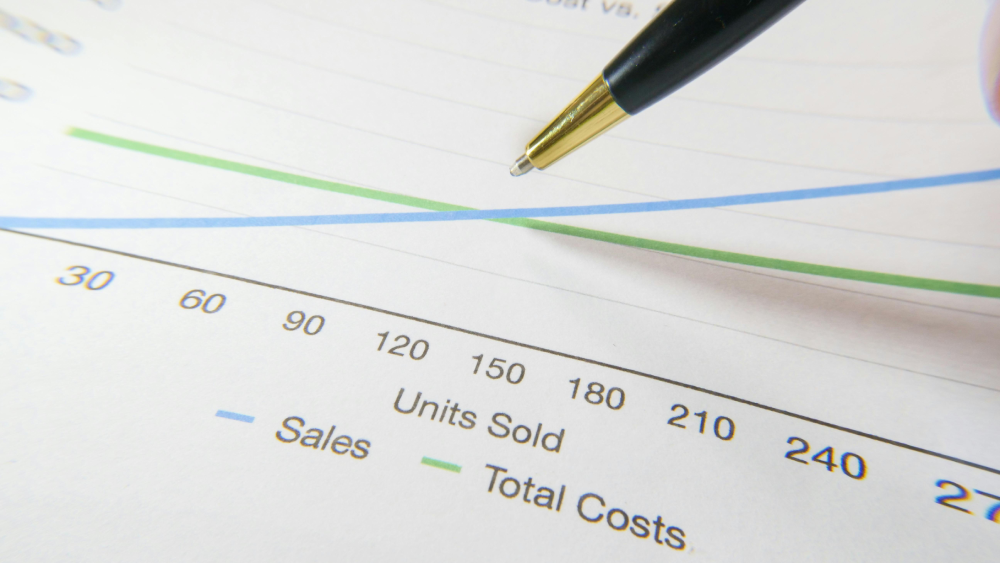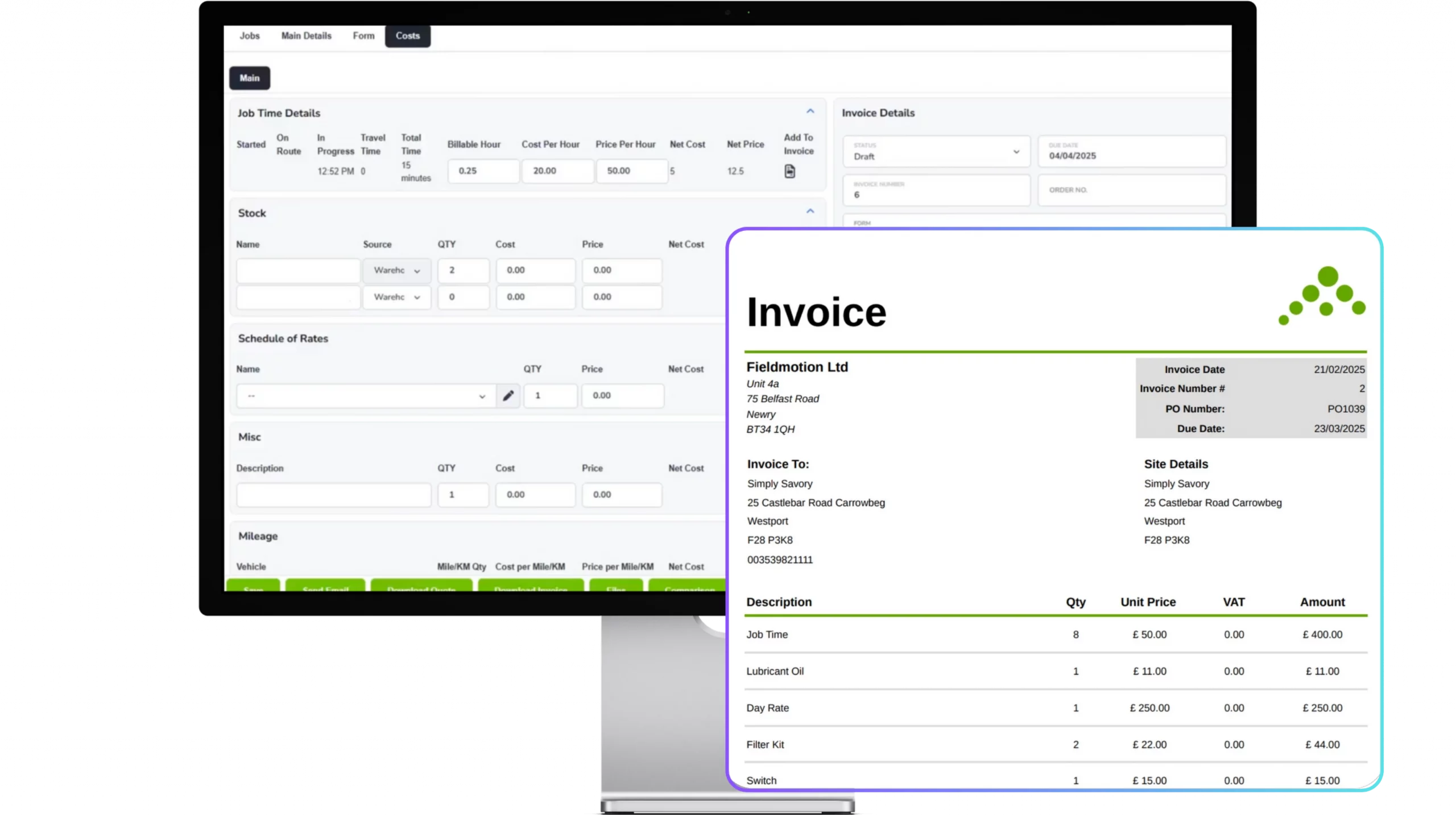Sales margin, often called gross profit margin, is one of the most straightforward financial metrics in business. But it’s also one that people often get wrong.
Put simply, it shows how much profit you’re making after covering your direct costs, expressed as a percentage of the selling price.
Mixing up margin with markup can lead to poor pricing decisions. In trades and field service businesses, where job costs can shift from one day to the next, that kind of mistake can quickly cut into your profits.
Contents
- Calculating Sales Margin: A Quick Breakdown
- Free Sales Margin Calculator
- Reverse Sales Margin Calculator
- What Is a Good Profit Margin in Field Service?
- Sales Margin vs Markup vs Gross Profit — What’s the Difference?
- VAT Considerations in the UK and Ireland
- When to Use a Margin Calculator (Real-World Scenarios)
- How Fieldmotion Helps Field Service Businesses Improve Margins
- Understanding Your Sales Margin

Calculating Sales Margin: A Quick Breakdown
The good news is that calculating your margin is easy — and absolutely essential if you want to price properly, quote with confidence, and keep your business profitable.
Here’s the formula:
Sales Margin (%) = (Selling Price − Cost Price) ÷ Selling Price) × 100
Breaking that down:
-
Selling Price is what you charge the customer
-
Cost Price includes all the costs to do the work — labour, materials, fuel, even subcontractor costs
-
Profit is what’s left after you cover those costs
Example: Basic Field Service Job
-
Selling Price: £120
-
Cost of Labour and Materials: £80
Margin = ((120 − 80) ÷ 120) × 100 = 33.33%
In this example, your margin is 33.33%. That means for every £1 earned, just over 33p is retained as profit before tax and overheads are considered.
Applying This to Field Service Work
In a typical field service business, the cost of delivering a job isn’t limited to materials. It often includes:
-
Wages or hourly rates for engineers and technicians
-
Fuel costs and vehicle wear
-
Parts, fittings, or consumables used
-
Any admin time or software licensing linked to job management
If you’re using a platform like Fieldmotion, you can pre-set your labour and parts costs within the system. That means you’ll see projected profit margins automatically as jobs are completed — no need for manual calculations later.

Free Sales Margin Calculator
Working out your profit margin manually for every job is time-consuming — especially if you’re quoting quickly or managing variable costs.
To simplify this, we’ve built a free, easy-to-use Sales Margin Calculator that allows you to:
-
Instantly see your margin and markup percentages
-
Toggle VAT on or off depending on the job
-
Switch between net and gross profit views
-
Work backwards to calculate what you should charge to achieve a specific margin
-
Save or export results for your records or to attach to quotes
Main Calculator Tool: How It Works
Input Fields:
-
Job Cost (excluding VAT)
-
Selling Price
-
VAT toggle (on/off)
-
Select net or gross profit view
Output Fields:
-
Total revenue
-
Total cost
-
Profit (net or gross, depending on your selection)
-
Margin (%)
-
Markup (%)
There’s also an option to print or export your calculations to PDF — handy for quoting, client records, or internal reviews.
Who this is for: Ideal for tradespeople, estimators, and job managers who need quick, accurate pricing whether on-site or in the office.
Margin % is based on the VAT-inclusive selling price if this option is enabled.
For net margin based on revenue excl. VAT, disable this setting.
Sales Margin Calculator
Reverse Calculator
Reverse Sales Margin Calculator
In some cases, you may know your job costs and your target margin, but not the final selling price. This is where a reverse calculator becomes useful — allowing you to work backwards from your desired profit.
Input Fields:
-
Cost price
-
Target profit margin (%)
-
VAT on or off toggle
Output:
-
Required selling price (excluding and including VAT)
-
Expected profit
-
Equivalent markup percentage
When to Use It: This tool is ideal for setting pricing strategies, testing margins for new services, or helping junior staff learn how to build profitable quotes.
Both the standard and reverse calculators are fully mobile-friendly and embedded directly in this article for quick access — whether you’re in the office or out on a job.
Fieldmotion Brochure
See how Fieldmotion helps field service teams manage jobs, schedule staff, create invoices, and communicate with customers — all from one easy-to-use system.
What Is a Good Profit Margin in Field Service?
There’s no single right answer when it comes to a “good” margin. Your ideal range will depend on the type of work you do, how efficiently you operate, and how competitive your market is.
However, here are typical benchmarks by industry:
| Industry | Typical Net Profit Margin |
|---|---|
| General Trades (Plumbing, Electrical) | 10% – 25% |
| HVAC Installation & Repair | 8% – 20% |
| Property Maintenance | 5% – 15% |
| Cleaning Services | 10% – 30% |
| Landscaping & Tree Services | 10% – 25% |
| Security System Installers | 15% – 30% |
Note: If your net margin is consistently under 10%, it may be time to review your pricing process. Issues with underquoting, unbilled extras, or poor cost tracking could be eroding your profitability.
Also keep in mind the distinction:
-
Gross Margin shows your profit before overheads like admin, insurance, or transport.
-
Net Margin reflects true profit after all costs are considered.
Even small improvements in margin can have a large impact. For example, raising your average profit margin by just 5% on £500,000 of annual revenue results in an additional £25,000 in profit.

Sales Margin vs Markup vs Gross Profit — What’s the Difference?
Many business owners use these terms interchangeably, but they measure different aspects of profitability. Understanding the difference is key to pricing your services correctly and protecting your bottom line.
1. Sales Margin (%)
Sales margin shows what percentage of your selling price is profit. It is useful for tracking how efficiently you’re converting sales into profit.
Formula:
(Selling Price − Cost) ÷ Selling Price × 100
Example:
-
Cost: £20
-
Selling Price: £30
-
Margin = (£10 ÷ £30) × 100 = 33.33%
This means one-third of your selling price is profit.
2. Markup (%)
Markup shows how much you increase your cost price by to arrive at the selling price. It’s helpful when setting prices based on known costs.
Formula:
(Selling Price − Cost) ÷ Cost × 100
Example:
-
Cost: £20
-
Selling Price: £30
-
Markup = (£10 ÷ £20) × 100 = 50%
Important: Markup and margin are not the same. A 50% markup only gives you a 33% margin.
3. Gross Profit (£)
Gross profit is the actual cash amount you earn after subtracting direct job costs such as materials and labour.
Formula:
Selling Price − Direct Costs = Gross Profit
Example:
-
Selling Price: £30
-
Direct Costs: £20
-
Gross Profit = £10
Why It Matters
-
Margin helps you evaluate business performance over time.
-
Markup helps you set prices.
-
Gross profit helps you track actual earnings per job.
In industries like plumbing, HVAC, electrical, or landscaping—where labour and material costs often change—using these three figures together allows you to quote more accurately, protect profits, and grow sustainably.

VAT Considerations in the UK and Ireland
If your business is VAT-registered, it’s important to calculate profit margins correctly by excluding VAT from your figures. Quoting or reporting based on VAT-inclusive prices can give a misleading picture of your profitability.
VAT in the UK
-
Standard VAT rate: 20%
-
For business-to-business (B2B) sales, VAT is usually shown as a separate line on invoices.
-
For business-to-consumer (B2C) sales, prices often include VAT.
Example:
-
Cost (excluding VAT): £100
-
Desired profit margin: 25%
-
Selling price (excluding VAT): £133.33
-
VAT (20%): £26.67
-
Total price charged to customer: £160.00
Tip: Always exclude VAT when calculating margin to ensure accurate profit analysis.
VAT in the Republic of Ireland
-
Standard VAT rate: 23%
-
Some services (e.g. construction, maintenance) may fall under a reduced rate of 13.5%.
Example:
-
Cost: €100
-
Selling price (excluding VAT): €150
-
VAT (23%): €34.50
-
Total charged to customer: €184.50
As in the UK, margin should always be calculated before VAT.
Using the Sales Margin Calculator?
-
If your selling price includes VAT, tick the “Include VAT” option.
-
If you quote or set prices excluding VAT, leave the box unticked.
Whichever method you use, always compare net revenue to net cost when working out your margins to avoid overestimating your profitability.

When to Use a Margin Calculator (Real-World Scenarios)
A sales margin calculator isn’t just for accountants. It’s a practical tool that business owners, estimators, and field managers should use regularly to protect profitability and improve decision-making.
Here are some common scenarios where it proves valuable:
1. Quoting for New Jobs
You’re pricing up a job and want to ensure your quote includes a solid profit.
How to use it:
Enter your expected labour and material costs, choose your target margin (for example, 30%), and the calculator will give you the minimum price needed to meet that margin.
2. Reviewing Profitability by Job Type
You want to assess whether certain services (such as boiler servicing or equipment installations) are more profitable than others.
How to use it:
Input historical data from completed jobs to calculate the actual margin achieved. Use this to refine your pricing or focus more on high-margin services.
3. Responding to Discount Requests
A client asks for a discount, and you’re unsure whether it’s still worth doing the job.
How to use it:
Use the reverse margin calculator to check whether the reduced price still leaves enough profit after costs.
4. Adjusting for Supplier Price Increases
Material or fuel prices go up, and you need to revise your pricing without reducing your profit.
How to use it:
Update your cost inputs, keep your desired margin fixed, and calculate the new selling price required to stay profitable.
5. Staff Training and Sales Education
You’re training new staff and want to ensure they understand the difference between margin and markup — and how to price accurately.
How to use it:
Use the calculator as a hands-on training tool to demonstrate real-world examples and pricing scenarios.
How Fieldmotion Helps Field Service Businesses Improve Margins
In field service, profit can easily be lost due to underquoted jobs, missed costs, or slow invoicing. Fieldmotion helps you stay in control by linking your quoting, job tracking, and invoicing into one connected workflow.
Quote Accurately with Built-In Pricing Logic
Fieldmotion lets your team quote based on:
-
Pre-set schedules of rates
-
Real-time labour and material costs
-
Optional add-ons or upsell items
-
Standardised quote templates
This ensures quotes are consistent, professional, and based on actual job data — not guesswork.
Generate Invoices Instantly from the Field
Once a job is completed, you can raise and send an invoice straight away — either as a standalone bill or bundled with other work.
-
Invoice directly from the job record
-
Automatically include all time, labour, and parts
-
Set up recurring invoices for maintenance contracts
-
Email invoices and job sheets immediately
This speeds up cash flow and ensures no chargeable work is missed.
Seamless Integration with Accounting Software
Fieldmotion integrates with:
-
Sage 50 (via export)
This keeps your financial records aligned across systems and reduces manual entry or reporting errors.
Monitor Gross Margin per Job
Track job profitability using:
-
Engineer time logs
-
Materials and consumables used
-
Job notes and variations
You’ll see where margins are being made or lost — helping you fine-tune pricing or improve efficiency over time.

Understanding Your Sales Margin
Understanding your sales margin — and having a reliable way to calculate and track it — is essential for any business in the field service sector. Rising costs, increased competition, and tighter margins mean that even small mistakes in pricing or quoting can have a big impact on your bottom line.
With the right tools and systems in place, you can:
-
Quote with confidence
-
Protect your margins
-
Get paid faster
-
Make informed decisions
Fieldmotion helps field service businesses simplify job management, invoicing, and profitability tracking — all in one place.
✅ Quote based on real costs
✅ Invoice on-site from mobile or tablet
✅ Track profit margins by job, customer, or team
✅ Sync with your accounting platform
Book a free demo here and see how Fieldmotion can help you turn better margins into real growth.




